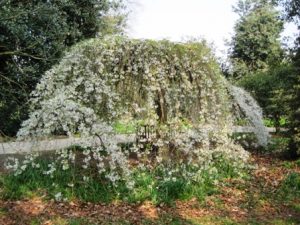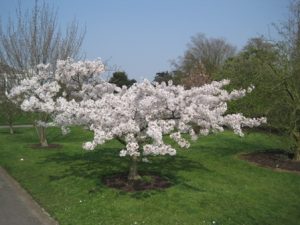Kew Gardens

Kew Gardens – Description:
Kew Gardens is one of the world’s leading botanic gardens.
There are 120 hectares of lawns, gardens, lakes, woods, follies, glasshouses and a treetop walk.
One in eight of all known plant species are collected here.
As well as providing a vast area in which people to walk and picnic, the gardens are also a location where serious scientific work is carried out.
Kew Gardens – History:
Kew Gardens was created by King George III when he inherited the Royal Estates of Kew Gardens, Richmond Gardens and various riverside properties. He made many changes to the gardens, restoring several buildings including the Pagoda. King George appointed Sir Joseph Banks as an advisor, Banks had sailed around the world with Captain Cook on board the Endeavour and had brought back a huge number of plants. These he grew at Kew assessing them for their ornamental, nutritional and medicinal properties.
At this time the botanic gardens occupied a small part of the site, with the rest being landscaped by Lancelot ‘Capability’ Brown who created the Rhododendron Dell and the lake which can still be seen. Over the succeeding years Banks made several more voyages of collection travelling all over the world and by the 1800s Kew Gardens had gained an international reputation and new plants were continually arriving from far flung places.
Kew Gardens – The Glass Houses:
After the death of George III in 1820 the gardens went into decline, however in 1841 they were handed to the state and in the mid 19th century several greenhouses were added.
The Palm House is built of wrought iron and 700 hand blown glass panels, it was the first large scale structural use of wrought iron and its construction borrowed from shipbuilding techniques. The Palm House contains tropical plants including palms, bamboo, tamarind, mango, giant hibiscus and frangipani. The leaves of many of these reach high into the air and an aerial walkway allows the visitor to walk among the fronds. In the basement is the Marine Display which includes seahorses and other fish in tanks.
To the north west of the Palm House is the steamy Waterlily House (closed in the winter) which houses various varieties of waterlily in a large pond including the giant Victoria cruziana.
The Temperate House, when completed 40 years after its construction was commenced in 1849 was the world’s largest greenhouse, and is the world’s largest surviving Victorian glass structure having a floor area twice that of the Palm House. The Temperate House contains plants from temperate regions from around the world and has an elevated gallery from which the visitor can enjoy views of them.
The Princess of Wales Conservatory was added in 1987 and computer controlled ventilation and heating systems in this glasshouse enable the maintenance of a range of 10 separate climatic zones from desert at one end to tropical at the other. Plants in the conservatory include cacti, orchids, waterlilies and carnivorous plants.
The Alpine House opened in 2006 is 16 metres long and 10 metres high at the tallest point of its arched structure. It relies on the aerofoil like shape of the greenhouse, automated windows and heat exchange technology to maintain the cool dry and windy conditions that alpine plants prefer without high energy usage. The special glass used in the construction allows 90% of ultra violet light to pass through and the glazing is supported by tensioned steel cables which removes the need for traditional glazing bars which would otherwise block a part of the light.
Kew Gardens – The Badger Sett:
Kew Gardens has recently opened a human size Badger Sett to show children how badgers live. It is located in the southwest corner of the Gardens close to a Wildlife Observation Centre. A giant forked oak branch leads visitors into the badgers’ subterranean world, where food stores, sleeping chambers and nests are connected by tunnels.

Kew Gardens – The Treetop Walkway:
The Treetop Walkway close to the Temperate House is an 18 metre high platform suspended on stilts which winds between the treetops for 200 metres, the perforated metal floor sways gently with the breeze. The treetop walkway is reached by stairs.
Kew Gardens – The Sackler Crossing:
The Sackler Crossing bridge provides a crossing over the middle of the Kew Gardens lake. From the shore the sides appear solid, however from the bridge they resolve into individual slivers of metal which allow a more open view across the lake.
Kew Gardens – The Pagoda:
The Pagoda was erected in 1762 and is 10 stories (50 metres) tall. It is a brick structure and each floor is octagonal with an overhanging roof in the Chinese style. The pagoda is open to the public and the top floor is reached by ascending 253 steps.
Kew Gardens – Queen Charlotte’s cottage:
Queen Charlotte’s cottage is in the Bluebell Wood in the western part of Kew Gardens and was given to the queen by George III as a wedding present.
Kew Gardens – The Orangery
The Orangery, near to Kew Palace, was completed in 1761 and contains a restaurant, cafe and shop.
Kew Gardens – Website:
Kew Gardens – Admission:
There is an admission fee of £13.90 for adults (children free) for Kew Gardens which includes entry to everything apart from Kew Palace for which there is a separate admission charge. The gates open at 9:30 every day except 24 and 25 December.
Kew Gardens – Kew Palace:
Kew Palace in the northwest of the gardens is the smallest of the royal palaces and was built around 1631. It is red brick with the bricks laid with the long and the short sides alternating in a style called Flemish Bond, this together with the gabled front give it a Dutch appearance and it was once known as the Dutch House. Inside are the Georgian rooms which have been restored to how they would have looked in 1804. To the rear are the Queen’s gardens which contain a collection of medicinal plants.
Kew Palace is open from 2 April 2012 to 30 September 2012:
11:00-17:00
Adult £5.30 Children (under 16) Free
Kew Gardens – Getting There:
Address: Richmond TW9 3AB
Nearest Underground Station: Kew Gardens (5 minute walk)